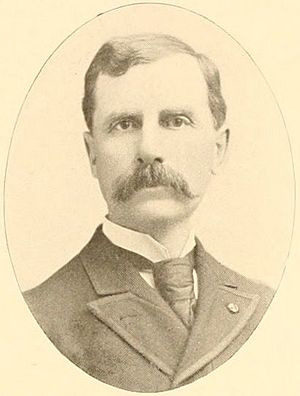J. Sumner Rogers facts for kids
Quick facts for kids
J. Sumner Rogers
|
|
|---|---|

From 1902's Officers of the Army and Navy (Volunteer) Who Served in the Civil War
|
|
| Born | July 5, 1844 Orrington, Maine |
| Died | September 14, 1901 (aged 57) Orchard Lake Village, Michigan |
| Buried |
Oak Hill Cemetery, Orrington, Maine
|
| Allegiance | Union (American Civil War) United States |
| Service/ |
Union Army United States Army Michigan Militia |
| Years of service | 1861-1863, 1864-1865 (Union Army) 1867-1877 (United States Army) 1877-1901 (Militia) |
| Rank | Major (Brevet) (Union Army) First Lieutenant (United States Army) Colonel (Militia) |
| Unit | U.S. Army Infantry Branch |
| Commands held | Company M, 31st Maine Volunteer Infantry Regiment Michigan Military Academy |
| Battles/wars | American Civil War |
| Spouse(s) | Jeanette Susan Wheeler (m. 1866-1901, his death) |
| Children | 3 |
J. Sumner Rogers (born July 5, 1844 – died September 14, 1901) was an American teacher and army officer. He was from Orrington, Maine. Rogers fought in the American Civil War. He is best known for starting and leading the Michigan Military Academy for many years.
Contents
Early Life and Education
Joseph Sumner Rogers was born in Orrington, Maine, on July 5, 1844. His parents were Joseph Rogers and Joanna Swett Harriman. Rogers was a descendant of Thomas Rogers, who traveled on the Mayflower. He went to school in Orrington. At age 16, he left school to join the Union Army during the American Civil War.
Military Service During the Civil War
In April 1861, Rogers joined the 2nd Maine Volunteer Infantry. He fought in the First Battle of Bull Run in July 1861. He also served during George B. McClellan's 1862 Peninsula campaign. Rogers was badly wounded in the face during the Second Battle of Bull Run in August 1862.
While recovering in Maine, Rogers finished his education at an academy in Bucksport, Maine. He left the army in June 1863 when his enlistment ended.
Rogers rejoined the army in September 1864. He became a first lieutenant in the 31st Maine Volunteer Infantry Regiment. He fought in many battles, including the Wilderness, Spottsylvania, and Cold Harbor. He also served during the Petersburg and the Crater.
His regiment then guarded areas around Petersburg, Virginia. They stayed there until the Confederate army surrendered. Rogers was promoted to captain in October 1864. He became a major by brevet in March 1865. He left the army with his regiment on July 15, 1865.
Post-Civil War Career
In October 1867, Rogers became a second lieutenant in the United States Army. He was assigned to the 1st Infantry Regiment. He served in Louisiana during the Reconstruction era. Later, he was stationed at Fort Wayne in Detroit.
While at Fort Wayne in 1872, Rogers was appointed a military science teacher. He taught at Detroit High School. He also led the Detroit Cadets, who were high school students trained in military drills. He commanded them as a major in the Michigan Militia until 1876. His cadets performed at the Centennial Exposition in Philadelphia. Rogers left the army in 1877. He planned to start his own military school.
Founding the Michigan Military Academy
Later in 1877, Rogers found people to help him financially. He bought the estate of Joseph T. Copeland in Orchard Lake Village, Michigan. There, he started the Michigan Military Academy. This was a boarding school designed like the United States Military Academy.
Rogers used his friendships from the Civil War to make his school famous. In 1879, William Tecumseh Sherman, a top general, spoke to the academy's graduating class. About 10,000 people came to hear him speak.
Rogers served as the school's superintendent. He held the militia rank of colonel. Under his leadership, the academy's drill teams won many national competitions. They also took part in events at the 1893 World's Columbian Exposition.
Around 1900, the school expanded, which caused it to go into debt. Rogers was very ill and could not lead as well as before. The school struggled financially.
Personal Life and Family
Rogers was a member of several groups, including the Freemasons and the Grand Army of the Republic. He also belonged to the Sons of the American Revolution and the Mayflower Society.
In 1866, Rogers married Jeanette Susan Wheeler (1845-1920). They had three children. Their son, Harry Lovejoy Rogers (1867-1925), graduated from the Michigan Military Academy. He joined the Army during the Spanish–American War. He later became a major general during World War I. Their daughter, Florence (1878-1890), sadly died at age 12. Their son, Frederick P. Rogers (1881-1946), was a businessman and army officer. He also became a major during World War I.
Death and Legacy
Rogers died in Orchard Lake on September 14, 1901. He was buried at Oak Hill Cemetery in Orrington, Maine.
The Michigan Military Academy continued until 1908. It then went bankrupt and closed. The academy's property was added to the National Register of Historic Places in 1982. It is now known as the Orchard Lake Schools Historic District.

